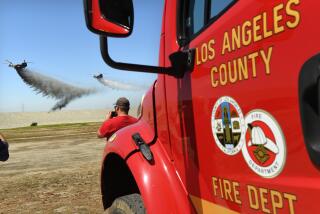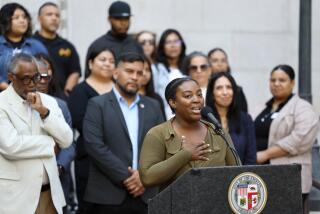Study Finds Fewer Donors to Charity
The economy may be flush, but a far smaller percentage of Los Angeles County residents donated to charity this year than last, falling below the state and national rates, a recent survey found.
Those who did give tended to be older, leaving charities worried that the percentage could decline further in the future. Most of the people mailing donations to the Salvation Army in Southern California, for example, are over 70, said Lt. Col. Alfred Van Cleef, the divisional commander.
“This is not just a statistical fluke,” said Allan Parachini, spokesman for the California Community Foundation, which commissioned the random telephone survey of 501 county residents Dec. 4-12, the third such poll in as many years. “It’s the beginning of a very worrisome trend.”
The poll by the Field Research Corp. of San Francisco has a margin of error of plus or minus 4.6 percentage points.
Fewer than two-thirds of households reported making a charitable donation in the past 12 months, compared to nearly three-quarters a year before. Statewide, a related poll found that 72% of Californians gave, while a separate survey put the national rate at 70%.
Younger donors in Los Angeles County were even harder to find; fewer than a quarter of those ages 18 to 24 gave to religious organizations in 1999, down from 43% a year before. Only one in 10 gave to nonreligious groups. The donation rate was somewhat higher for residents ages 25 to 34; 38% made contributions to religious groups and 20% gave to nonreligious entities.
The Internet, which appeals to a younger crowd, has not helped to bridge the generational donation gap--fewer than four in 10 Internet users said they would feel comfortable making an online donation, the survey found.
Some groups, however, have had success in reaching out to younger donors by including them on their boards of directors. Bet Tzedek Legal Services put Randall Kaplan, 31, on its board and he developed the Justice Ball, an annual fund-raiser held at the House of Blues in West Hollywood that caters to younger people.
“There are literally thousands and thousands of young people [locally] who are waiting to get involved in causes that they relate to and believe in,” said Kaplan, founder and managing partner of JUMP Investors, which invests in early stage Internet companies.
The statewide poll appeared to back the notion that the county’s young adults could be persuaded to give more. Across California, 60% of respondents ages 18 to 29 said they donated to charity, compared with 42% in Los Angeles County.
Still, both rates were below the percentage of givers in the overall population. Like younger people, lower-income households in Los Angeles County gave at a lower rate. Close to two-thirds of those earning less than $20,000 made no contributions, as did nearly a third of those earning between $20,000 and $60,000.
Among county residents who did give, 43% said it would be very difficult to increase their donation by even $100.
The proportion of residents giving to religious organizations, including church collections, was down to 40%, from 50% last year, and those polled were less likely than respondents in previous years to give through religious channels, the survey found. More than half felt that local businesses and corporations should be encouraged to be active in local charities.
Forty percent of respondents did some volunteer work, a percentage similar to those in the previous two years. People who volunteered were more likely to contribute money, the survey found.
The drop in donors has not necessarily translated into less money, especially for foundations. The California Community Foundation expects an all-time high this quarter in collections, Parachini said, but he added that more money is coming from fewer sources.
“While dollarwise things may be OK, if it’s generational, it’s really sowing seeds of trouble for the future,” he said.
Smaller donations are definitely off, Van Cleef said. The Salvation Army has collected only $900,000 in the hundreds of red Christmas kettles set up in front of supermarkets, department stores and plazas in the area, far short of its goal of $1.6 million, he said. Last year, the organization collected $1.5 million.
Wednesday’s report came as no surprise to Manuel Gaytan. The Salvation Army volunteer dutifully rang his bell in front of the Union Bank Plaza downtown at noon, seeking money for his red bucket, but many people breezed by him without so much as a glance. Two hours brought only 10 donations, he said.
“It’s so slow. I don’t know what to think,” said Gaytan, adding that 10 times as many people gave when he rang the bell in the area two years ago.
(BEGIN TEXT OF INFOBOX / INFOGRAPHIC)
Little Charity
Here is a look at how much Los Angeles County residents said in a telephone survey that they gave to charity in 1999.
More than $1,000: 14%
$501-$1,000: 12%
$101-$500: 20%
$1-$100: 12%
None: 37%
Don’t know/no response: 5%
*
Here, by age group, is the percentage of Los Angeles County residents who said they gave to nonreligious charities in 1999.
18-24: 10%; % point change compared with 1998 survey: 12
25-34: 20%; % point change compared with 1998 survey: -1
35-44: 27%; % point change compared with 1998 survey: 6
45-59: 29%; % point change compared with 1998 survey: 5
60 and older: 21%; % point change compared with 1999 survey: 2
*
Source: Field Research Corp.
More to Read
Sign up for Essential California
The most important California stories and recommendations in your inbox every morning.
You may occasionally receive promotional content from the Los Angeles Times.









